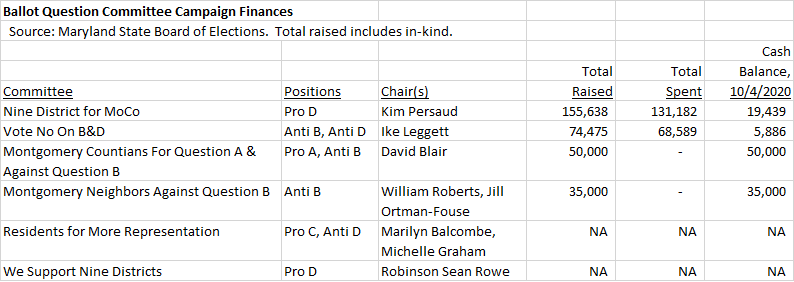By Adam Pagnucco.
The six committees formed to advocate for and against MoCo’s ballot questions have filed their final campaign finance reports before the general election, covering the period through October 18. Let’s see where the money is coming from.
First, a quick summary of the ballot questions.
Question A: Would freeze the property tax rate but allow a unanimous vote of the council to increase it. Authored by Council Member Andrew Friedson.
See Why Progressives Should Support the Friedson Amendment.
Question B: Would remove the ability of the county council to break the current charter limit on property taxes, thereby capping property tax revenue growth at the rate of inflation. Authored by Robin Ficker.
Question C: Would add 2 district seats to the county council, thereby establishing 7 district seats and 4 at-large seats. Authored by Council Member Evan Glass.
See MoCo Could Use More County Council Districts.
Question D: Would convert the current council’s 5 district seats and 4 at-large seats to 9 district seats. Authored by Nine District for MoCo.
See Don’t Abolish the At-Large County Council Seats, Nine Kings and Queens.
Here is a summary of finances for the committees for the entire cycle through October 18.

To understand why these flows of money are occurring, it’s useful to recall the genesis of these questions. This year’s ballot question fight was joined when two questions were placed on the ballot by petition: Robin Ficker’s anti-tax Question B and Nine Districts for MoCo’s Question D, which would eliminate council at-large seats and remake the council into 9 district seats. In response to those ballot questions, the county council put two of its own questions on the ballot to compete with them: Question A (a different tax limitation measure) and Question C (which would keep the at-large seats and add two district seats). It is believed by some that if two directly conflicting ballot questions pass, they will both get thrown out, though that is not 100% certain.
Once it became clear that both Ficker’s anti-tax question and the nine districts question were going to appear on the ballot, no fewer than four new ballot issue committees were created to stop one or both of them and/or to promote the council’s alternatives. In short order, many of the county’s power players took sides in an uncommon off-year ballot question war. The players’ positions are at least as interesting as the committees’ activities themselves.
Nine Districts for MoCo, the oldest of the committees, has by far the most individual contributors but 82% of its cash funding has come from the real estate industry. In its most recent report, MoCo GOP Central Committee Member Ann Hingston made 6 more in-kind contributions totaling $993, thereby providing more evidence of the links between Nine Districts and the county Republican Party. Nine Districts’ fundraising pace has slowed as they have collected just $154 since October 4.
The competing committees have rapidly closed the gap. Three groups have paid for mail: former County Executive Ike Leggett’s group opposing Questions B and D, former executive candidate David Blair’s group supporting Question A and opposing Question B and Residents for More Representation, a group supporting Question C and opposing Question D. These groups are also paying for websites and online advertising. But they got off to a late start while Nine Districts has been campaigning for more than a year.
Below are all the major players who have contributed at least $10,000 to one or a combination of these ballot issue committees.
David Blair – $165,000
Supports Questions A and C, opposes Questions B and D
Businessman and former executive candidate David Blair is the number one spender on ballot questions. He has contributed $65,000 to Legget’s group opposing Questions B and D, $50,000 to his own group supporting Question A and opposing Question B, and $50,000 to Residents for More Representation, which supports Question C and opposes Question D. Blair’s positions mirror the positions taken by the county Democratic Party. (Disclosure: I have done work for Blair’s non-profit but I am not involved in his ballot question activities.)
Charlie Nulsen – $123,500
Supports Questions A, C and D, opposes Question B
Nulsen is the president of Washington Property Company. On June 4, he contributed $50,000 to Nine Districts to help get Question D on the ballot. On October 13, he contributed $23,500 to Residents for More Representation to defeat Question D. Nulsen could have saved more than $70,000 and achieved the same outcome by simply doing nothing. He also contributed $50,000 to Blair’s group supporting Question A and opposing Question B.
Monte Gingery – $40,000
Supports Question D
The head of Gingery Development Group has made three contributions totaling $40,000 to Nine Districts.
Willco – $40,000
Supports Questions C and D
On August 5, this Potomac developer gave an in-kind contribution of $15,000 to Nine Districts which was used to pay Rowland Strategies (their campaign firm). On October 9, Willco gave $25,000 to Residents for More Representation, which is seeking to pass Question C and defeat Nine Districts. Folks, you can’t make it up.
MCGEO – $30,000
Supports Question A, Opposes Question B, Gave Contribution to Question D
The Municipal and County Government Employees Organization (MCGEO) has made a $20,000 contribution to Montgomery Neighbors Against Question B and a $10,000 in-kind contribution to Nine Districts. MCGEO President Gino Renne is the treasurer of Empower PAC, which gave another $5,000 to Montgomery Neighbors Against Question B.
MCEA – $20,000
Opposes Question B
The Montgomery County Education Association (MCEA) has contributed $20,000 to Montgomery Neighbors Against Question B.
UFCW Local 400 – $10,000
Opposes Question B
This grocery store union which shares a parent union with MCGEO gave $10,000 to Montgomery Neighbors Against Question B.
The Montgomery County Democratic Party recommends voting for Questions A and C and voting against Questions B and D. The Montgomery County Republican Party recommends the exact opposite. The Washington Post editorial board opposes all four ballot questions.


